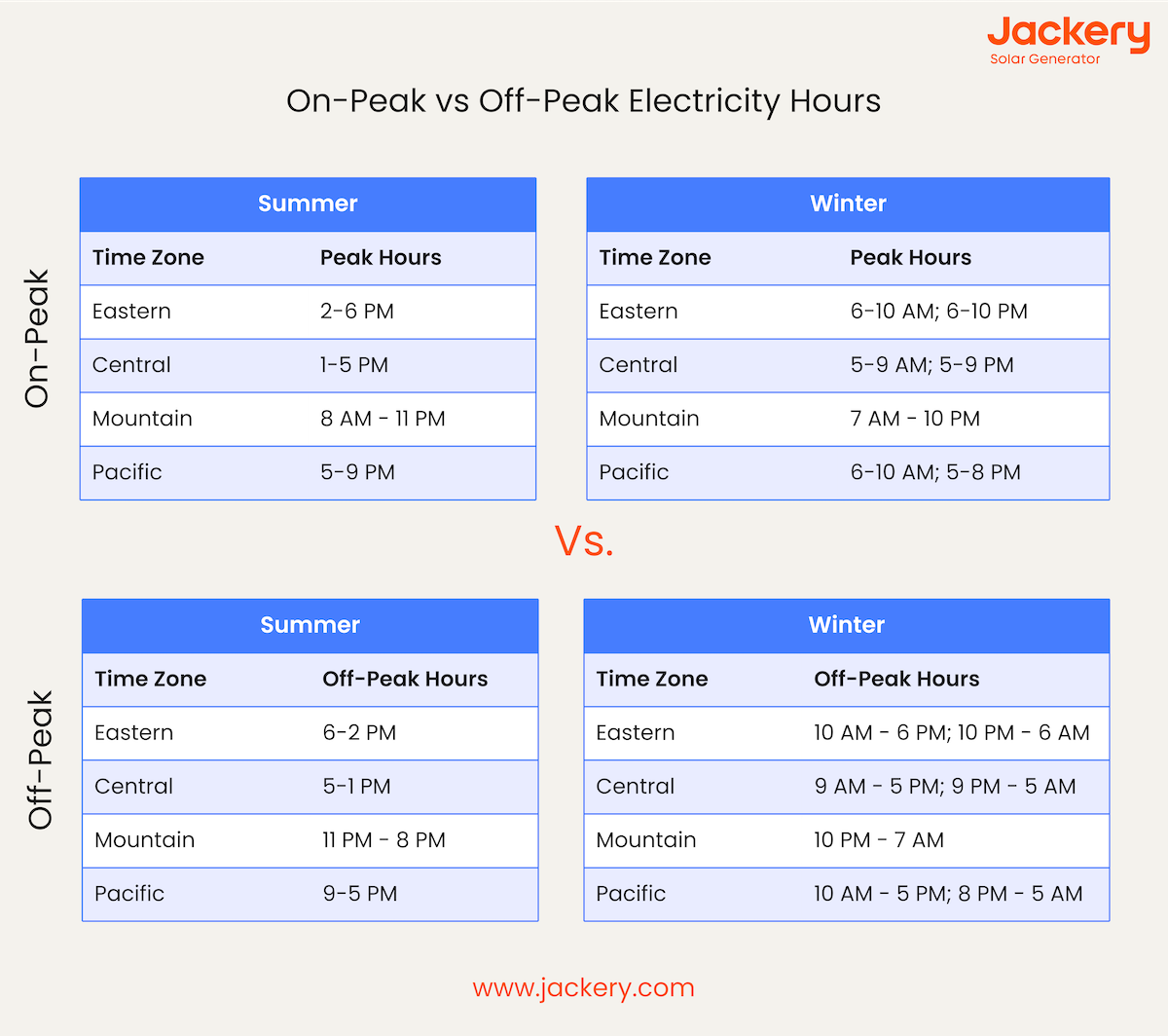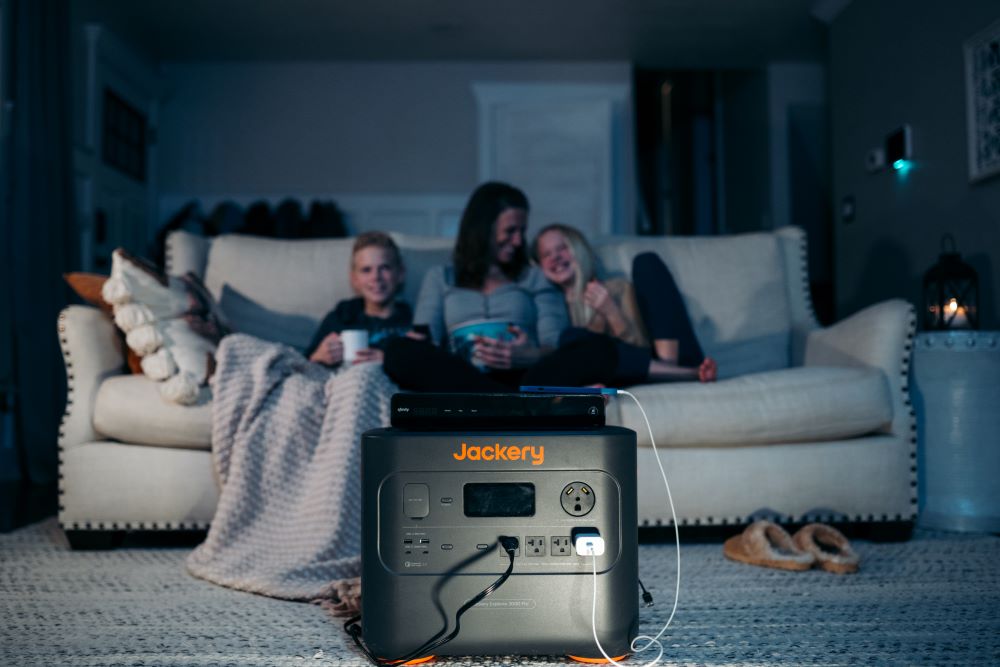Unlike a standard electricity plan that charges customers the same electricity rate throughout the day, the Time of Use (TOU) plans have different electricity costs during peak and off-peak hours. The off-peak electricity hours typically occur at night or at midday, especially when the electricity demand is low. Under TOU plans, the utility companies charge less during off-peak hours.
Jackery Solar Generators are designed to supply continuous and stable electricity to most indoor or outdoor appliances. These home battery backups can charge heavy-duty appliances, including ACs, refrigerators, washing machines, microwaves, etc. You can plug in the appliances to the battery backup to reduce the overall electricity consumption and bills.
What Are Off-Peak Electricity Hours?
Off-peak electricity hours are the times when electricity costs are cheaper. This is because fewer people access the electricity from the utility grid. Since there is less overall demand for electricity, utility companies have to pay less to generate electricity. Hence, customers don't have to pay higher rates for each kWh.
Certain utility companies offer TOU plans with a third tier called super off-peak electricity hours. These are the least expensive times to use electricity and typically occur between 11 PM and 7 AM. They are primarily used to balance energy usage patterns over the day and contribute to a steady energy supply.
|
Time Zone |
Off-Peak Hours |
|
Eastern |
Summer: 6 PM - 2 PM Winter: 10 AM - 6 PM; 10 PM - 6 AM |
|
Central |
Summer: 5 PM - 1 PM Winter: 9 AM - 5 PM; 9 PM - 5 AM |
|
Mountain |
Summer: 11 PM - 8 PM Winter: 10 PM - 7 AM |
|
Pacific |
Summer: 9 PM - 5 PM Winter: 10 AM - 5 PM; 8 PM - 5 AM |
Why Should People Use Electricity in Off-Peak Hours?
Some utilities offer discounted rates for homes or businesses to shift their energy use to off-peak electricity hours. There are many other reasons to use electricity during the off-peak hours, including:
Cost Savings
Some energy providers offer a reduced per-kWh rate during off-peak hours, which allows you to power home appliances at a lower cost than during peak hours. When you use energy-intensive appliances during off-peak hours, it costs you less and reduces your overall electricity bills.
Environmental Impact
Using home appliances during the off-peak electricity hours does not just benefit your wallet, but it's also a good choice for the environment. Shifting usage to off-peak times decreases strain on the power plants and reduces the consumption of fossil fuels. Thus, it helps in making the planet clean and green.
Load Balancing
When more people draw electricity during off-peak hours, the strain on the utility grid during peak electricity hours is reduced. Hence, it helps balance the energy load across the grid and improves overall grid stability.
Managing Home Appliances
Running heavy-duty home appliances like dishwashers, washing machines, etc., during low-demand hours not only lowers energy bills but also extends their lifespan.

Peak Vs. Off-Peak Electricity Hours
Peak hours electricity is when electricity consumption is higher than off-peak times. During these times, you'll have to pay additional costs called peak pricing. However, the exact cost will depend on the utility company and the specific electricity rate plan you choose. Peak electricity hours occur typically on weekday mornings and evenings.
The diagram below reveals the peak vs. off-peak electricity hours at different places.

The primary strategy for peak and off-peak electricity hours is to shift electricity usage to different times of day. When electricity consumption is high in terms of amount and frequency, it's hard to generate power to meet the demand. The TOU plans are preferred to shift electricity consumption towards off-peak times when there is low demand.
Why Are Utilities Switching to Time of Use Plans?
Time of Use (TOU) plans are a type of electricity billing with varying electricity costs based on the time of day. These plans are generally offered to residential customers. The aim behind the TOU plans is to reduce electricity consumption when the electricity rate is higher (during peak hours) and shift usage to off-peak hours.
While the electricity rate differs for consumers, there are also varying prices for utility companies producing electricity at different times of the day. Generally, the cost of generating electricity is higher during peak hours, and that's why utilities follow TOU plans to manage the overall cost. Here are a few things to consider before choosing TOU rates:
Type of Electricity Rate Plans
First, you'll need to consider different types of electricity rate plans. Utilities companies offer different residential plans, such as Time of Use, tiered, solar rate, and other utility-specific special rates. Let's explain them briefly:
- Time of Use Plans: It varies based on the season and time of day. The electricity rate is typically higher during peak hours and lower during off-peak hours.
- Tiered Rate Plans: Some utility companies charge a higher electricity rate if you use a higher amount of electricity regularly. In some cases, these plans work as TOU plans.
- Solar Rate Plans: If you have solar panels, the company may offer special plans that take this into account.
- Other Utility-Specific Special Rates: You can also choose special programs if you are charging EV during off-peak hours or simply reduce the overall energy consumption for certain days each year.
The best way to choose an electricity rate plan is to review the different options available on the website.
Time of Electricity Peak Hours
During peak hours, your electricity cost will be higher. The exact electricity hours and the premium you pay for electricity will depend on the utility company and the rate plan you are choosing. The time when the electricity is cheap will depend on the utility company.
On the East Coast, it will be hot around 2 PM, and homeowners will be using air conditioning systems. Thus, it isn't surprising that peak hours will be during the afternoon (2 PM - 6 PM) and the electricity rates will be higher. However, the peak electricity hours will change to early mornings in winter as everyone will be turning up their heating systems.
It's important to remember that every utility plan is different. Hence, you should always check the specifics and consider the impact of peak hours for electricity on the rate plan. If you want to take advantage of lower rates during off-peak hours, find out the specific time when the rate is lower.
Remember, the hours might differ in the summer versus the winter. You can lower the energy consumption by adjusting the smart thermostat so the heating and cooling system does not run extra. Additionally, you can invest in newer smart appliances and schedule when they run. It will help you move those tasks to times when the electricity price is lower.
How Much Money Could You Save During Off-Peak Electricity Hours?
Believe it or not, you can save a lot of money by using appliances during off-peak electricity hours. As the electricity rates are low during these times, it helps you reduce the overall utility bill. The exact saving amount will vary depending on how much electricity you consume from peak hours to off-peak hours.
While you are still drawing the same amount of electricity to do the laundry, the rates are lower in off-peak times. Running heavy-duty appliances, such as air conditioners, washers, etc., when electricity prices are lower can have a positive impact on your electricity bills. Here are some ways to save money during off-peak hours.
Use More Electricity During Off-Peak Hours
If you are strategically changing the energy use from peak to off-peak hours, it can provide you with energy and moving savings. Your total savings will be based on the overall electricity consumption and the amount moved to off-peak hours.
Many appliances like dishwashers, dryers, and washing machines have scheduling features and can be set ahead of time. This means you can set them to work during the off-peak hours and reduce electricity bills. Additionally, if you charge electric vehicles at home, adjust their timings and switch to night time charging when there are off-peak hours.
Utilize Jackery Solar Generators
While it may be possible to change some habits to use electricity during off-peak hours, it might not be possible to use all the appliances at that time. That's where it's a wise idea to look for a better alternative. One way to reduce overall electricity bills is to invest in a reliable solar generator.
For example, the Jackery Solar Generators are designed to charge most small and large home appliances during peak or off-peak hours for electricity. They also keep you protected from extended power outages or blackouts.
The large Jackery Solar Generator 2000 Plus and the Jackery Solar Generator 3000 Pro can charge 99% of home appliances throughout the day. They combine the portable Jackery Explorer Portable Power Stations and foldable Jackery SolarSaga Solar Panels to practice an off-grid lifestyle and save electricity costs.
Jackery Solar Generators Explained
Solar generators convert free solar energy into usable electricity to charge most home appliances for hours. They do not emit toxic fumes or noise while charging the appliances, making them a safe choice for indoor use cases. In addition, they do not have moving parts and require little to no maintenance.
Jackery is a renowned solar brand that manufactures portable solar generators, power stations, and solar panels. The Jackery Solar Generators consist of portable Jackery Explorer Portable Power Stations and foldable Jackery SolarSaga Solar Panels to collect, convert, and charge household appliances.
When the free sun's rays fall on the monocrystalline silicon solar cells of the Jackery SolarSaga Solar Panels, the solar energy is absorbed and converted to DC electricity. Then, the Jackery Explorer Portable Power Stations convert the DC to usable AC electricity to power a wide range of household appliances.
Jackery Solar Generator 3000 Pro
The Jackery Solar Generator 3000 Pro supports a large 3024 Wh capacity to charge up to 99% of household appliances. Its pull rods and double wheels help you move the battery backup from one place to another. You can use the 6*Jackery SolarSaga 200W Solar Panels to charge the Jackery Explorer 3000 Pro Portable Power Station in only 3.5 hours. The solar emergency generator can also be integrated into the home circuits via the Jackery Manual Transfer Switch to start charging 6 home appliances in the blink of an eye.

|
Jackery Solar Generator 3000 Pro |
|
|
Capacity |
3024 Wh |
|
Battery Cell |
NMC |
|
Cycle Life |
2000 cycles to 70%+ capacity |
|
Dimension |
Length: 18.6 in (47.3 cm) Width: 14.1 in (35.94 cm) Height: 14.7 in (37.36 cm) |
|
Recharging Methods |
AC Adapter: 2.4 Hours Car Adapter (12 V): 35 Hours 6*Jackery SolarSaga 200W Solar Panels: 3.5 Hours |
|
Output Ports |
AC Output (x1): 120 V~ 60 Hz 25 A Max AC Output(x3): 120 V~ 60 Hz 20 A Max USB-A Output (x2): Quick Charge 3.0x2, 18 W Max USB-C Output (x2): 100 W Max, 5 V⎓3 A, 9 V⎓3 A, 12 V⎓3 A, 15 V⎓3 A, 20 V⎓5 A |
|
Working Hours |
Dishwasher (1500 W): 1,7 H Washing Machine (1500 W): 1.7 H Iron (800 W): 3.2 H Clothes Dryer (1000 W): 2.5 H Water Heater (1100 W): 2.3 H |
|
Customer Review |
“It is so easy to set up and easy to transport and charge when stopped or driving. It powered our portable fridge/freezer, allowing us to meal prep the first 3 weeks of the trip. We have now purchased the 3000 for home backup and couldn’t be happier with its quick charging and larger solar panels.” — James. |
Jackery Solar Generator 2000 Plus
The expandable Jackery Solar Generator 2000 Plus features a safe and stable LiFePO4 battery. It has a battery of 2042.8 Wh capacity that can be expanded to 24 kWh with the additional Jackery Battery Pack 2000 Plus. It can charge up to 99% of household appliances, including refrigerators, lights, and medical equipment like CPAP machines. The Jackery Explorer 2000 Plus Portable Power Station can be recharged in only 2 hours using foldable 6*Jackery SolarSaga 200W Solar Panels.

|
Jackery Solar Generator 2000 Plus |
|
|
Capacity |
2 kWh - 24 kWh |
|
Battery Cell |
LiFePO4 |
|
Cycle Life |
4000 cycles to 70%+ capacity |
|
Dimension |
Length: 14.7 in (37.36 cm) Width: 18.6 in (47.3 cm) Height: 14.1 in (35.94 cm) |
|
Recharging Methods |
AC Adapter: 2 Hours Car Adapter (12 V): 25 Hours 6*Jackery SolarSaga 200W Solar Panels: 2 Hours |
|
Output Ports |
AC Output (×4): 120 V~ 60 Hz, 20 A Max AC Output (×1):120 V~ 60 Hz, 25 A Maximum USB-A Output (x2): Quick Charge 3.0, 18 W Maximum USB-C Output (x2): 100W Maximum, (5 V, 9 V, 12 V, 15 V, 20 V up to 5 A) |
|
Working Hours |
Dishwasher (1500 W): 1.1 H Washing Machine (1500 W): 1.1 H Iron (800 W): 2,1 H Clothes Dryer (1000 W): 1.7 H Water Heater (1100 W): 1.5 H |
|
Customer Review |
“Living in the Florida Keys, we have to prepare for hurricanes. Irma put us without electricity for 10 days. I ordered systems for both our children and us for their homes. Once I gave the equipment a try out for 48 hours, we were very happy and felt good about comfortably living through the next bad hurricane.” — Steven Holmes. |
Jackery Solar Generator 2000 Pro
The Jackery Solar Generator 2000 Pro has an NMC battery of 2160 Wh and a 2200 W inverter with a 4400 W surge peak output. It can be fully recharged in under 2.5 hours using 6*Jackery SolarSaga 200W Solar Panels. The home battery backup can power 96% of household appliances, such as refrigerators, microwaves, ovens, LED lights, and more. The Jackery Explorer 2000 Pro Portable Power Station has a sturdy, foldable handle to move the battery backup anywhere you want.

|
Jackery Solar Generator 2000 Pro |
|
|
Capacity |
2160 Wh |
|
Battery Cell |
NMC |
|
Cycle Life |
1000 cycles to 80%+ capacity |
|
Dimension |
Length: 15.1 in (38.4 cm) Width: 10.5 in (26.9 cm) Height: 12.1 in (30.75 cm) |
|
Recharging Methods |
AC Adapter: 2 Hours Car Adapter (12 V): 24 Hours 6*Jackery SolarSaga 200W Solar Panels: 2.5 Hours |
|
Output Ports |
AC Output (x3): 120 V, 60 Hz, 2,200 W (4,400 W Peak) USB-A Output (x2): Quick Charge 3.0, 18 W Maximum USB-C Output (x2): 100 W Maximum, (5 V, 9 V, 12 V, 15 V, 20 V up to 5 A) |
|
Working Hours |
Dishwasher (1500 W): 1.2 H Washing Machine (1500 W): 1.2 H Iron (800 W): 2.2 H Clothes Dryer (1000 W): 1.8 H Water Heater (1100 W): 1.6 H |
|
Customer Review |
“Peace of mind knowing we have a backup in the event of a power failure. A very nice, powerful unit that is super easy to use and fast charging. Have powered several appliances in the house. I have recently purchased a second Explorer 2000 Pro to alternate with the first when recharging is required. We are now prepared for an emergency.” — Richard W. |
Off-Peak Electricity Hours FAQs
What is the cheapest time of day to use electricity?
The cheapest time typically occurs late at night or early in the morning, when the demand for electricity is lower. Running the heaviest loads during off-peak hours can help you save on electricity bills.
What time is electricity most expensive?
Electricity prices are typically higher during the peak hours (4 PM to 9 PM), especially when the demand for electricity is higher. The exact peak hours may vary depending on the energy provider and the TOU plan's rate.
What uses the most electricity in a home?
The typical household appliances driving up your electricity bills include heating and cooling (45-50%), water heater (12%), lighting (9-12%), refrigerator (8%), washer and dryer (5%), electric oven (3%), and dishwasher (2%).
How do you use off-peak electricity?
There are many ways to save electricity with TOU plans, such as shifting electricity use to off-peak times. Consider running appliances like dishwashers, clothes dryers, and washing machines at off-peak times to avoid paying additional fees and high electricity rates.
Final Thoughts
Peak and off-peak electricity hours allow households and utility companies to better manage supply and demand. Time-of-use plans and rates typically vary from one utility company to another. It's always a wise idea to check the TOU plan and the off-peak electricity hours from the official website of the utility company.
If you want to reduce the overall electricity consumption, consider investing in solar generators that work on free solar energy. Whether you are choosing to sign up for a time-of-use plan or not, going solar can help you significantly reduce the reliance on the electricity grid.
Jackery Solar Generators are reliable and efficient home battery backup solutions that can charge most household appliances. This way, you can reduce household electricity bills and switch to clean energy.




















































































































Leave a comment